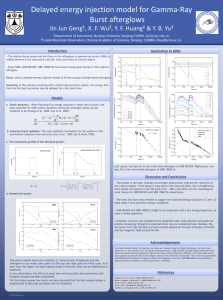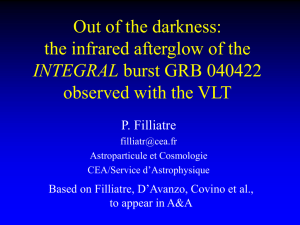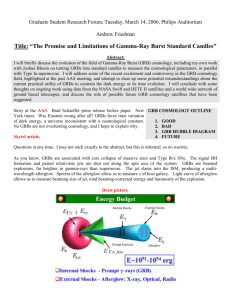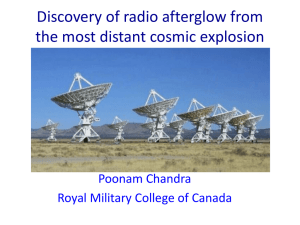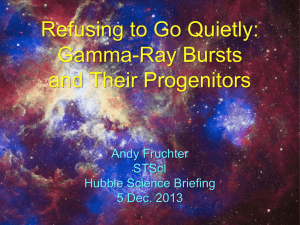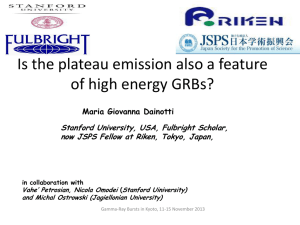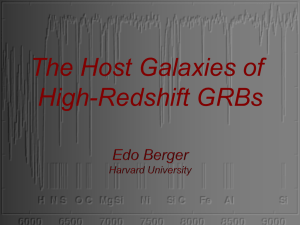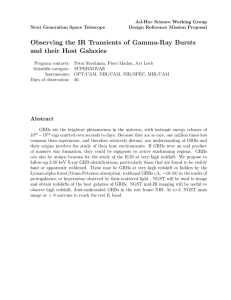slides
advertisement
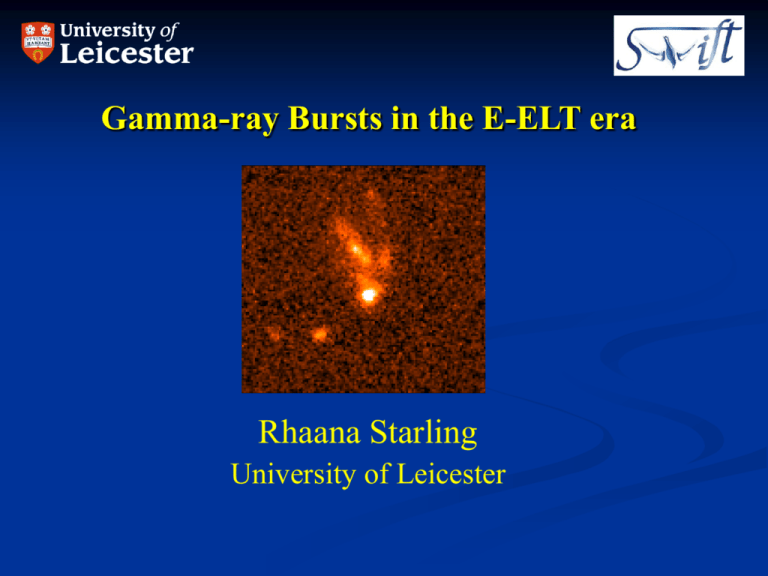
Gamma-ray Bursts in the E-ELT era Rhaana Starling University of Leicester Gamma-ray Bursts (GRBs) » Rates: Swift ~100 GRBs /yr » Afterglow has a synchrotron spectrum » Broad luminosity function (R~16 to >24 @1hr), power law decay » Redshifts: <z> = 2.3 (highest 6.3, pre-Swift <z> ~1.0) Galama et al 1998 » Classification: Short / long GRBs » Long GRBs == Type Ib/c core collapse SNe Radio X-rays Redshift distribution of GRBs cumulative histogram of Swift GRBs with redshifts Jakobsson et al. 2006 updated 1 April 2008 E-ELT will give us: Many more photons (from day one) » Obtain high resolution spectroscopy routinely » Go after the afterglows of the more elusive GRB sub-groups ie dark bursts, short bursts » reach the faint end of the luminosity function for GRB hosts » Allow polarimetry on a number of GRB afterglows to reveal jet structure and physics Greater spatial resolution (with laser guide star AO in place) » Accurately locate GRBs within their host galaxies and study nearby host galaxies in great detail (eg stellar population studies) Afterglow spectroscopy: host galaxies in absorption Kinematics: outflows of 22-2900km/s observed (stellar wind? Galactic winds? Halo gas?) more structure beyond current resolution? (VLT UVES to 7.5km/s for brightest few which are likely to have highest densities). At current rate would take ~10 years to have sample size 50: E-ELT statistically meaningful samples in much shorter timespan and sample wider population of afterglows and hosts. Host chemistry: redshift, abundances, metallicity, DLA (HI), densities and temperatures, search for H2 (1 tentative detection so far) GRB 050730 DLA metallicity Z ~ 0.01 Zsun redshift z = 3.97 Lyman limit z=3.97 metal lines WHT ISIS Starling et al. 2005 Time-resolved afterglow spectroscopy Indirect UV pumping of fine structure lines line variability. Used to derive important parameters like •ISM density •temperature •abundances •GRB absorber distance (102-103pc) •Or work back to derive UV radiation from GRB ONLY BRIGHTEST FEW% GRB 060418 UVES RRM, Vreeswijk et al 2007 Host galaxy spectroscopy Hosts are faint and at high z Usually… Want to derive properties of stellar population and metallicity to input into GRB progenitor models Only feasible now for closest/brightest subsample GRBs select a population of galaxies independent of their luminosity GRB 040924, Wiersema et al. 2008 GRB 060206, Thöne et al 2008 VLT (PI:Hjorth) and Gemini (PI:Levan) host galaxy surveys: <R> ~25.5 (of 2/3 detected) Massive stars and stellar populations in GRB hosts Are GRB hosts WR galaxies? Search deep in GRB hosts 980425, 020903 (Hammer et al,. 2006, right) and 060218 (Wiersema et al. 2008) Wolf-Rayet stars may be progenitors of GRBs Compare the host stellar populations to local galaxy stellar pops. Many more photons » Go after the afterglows of short bursts ~25% of GRBs are short-duration and likely have very different origins from the long GRBs: compact binary merger? We do not know! DSS and inset VLT images of the location of the first short burst afterglow showing a probable elliptical host. Gehrels et al. 2005; Hjorth et al. 2005. Afterglows are few mags fainter than for long GRBs – afterglow spectroscopy so far impossible Many more photons » Go after the afterglows of dark bursts Dark bursts have optical emission which is much fainter than expected from the standard GRB model (eg Jakobsson et al. 2005; Rol et al. 2007). Could be due to anomalously large dust columns (GRB sites usually have low dust content, but some dark GRB hosts are EROs), or high-z which can be probed with E-ELT. Probe of dusty galaxies through afterglow spectroscopy Swift: ~20% dark Spatial resolution: Are GRB-producing regions special? Afterglow lies in a region of average metallicity, not the expected low-Z WR region The brightest host: GRB 980425 at z=0.008 with VLT VIMOS, Christensen et al. submitted How much spatial resolution will we get with E-ELT? E-ELT could resolve a single star forming region of size say 100pc up to z=0.1 with a resolution of 50mas per pixel. Many more photons » Obtain high resolution spectroscopy routinely Complement high resolution X-ray spectral studies using eg Estremo, Xeus, Con-X Probe the WHIM in absorption, backlit by GRB afterglow. GRBs with E-ELT GRB science goals for E-ELT that we cannot do now: » High resolution spectra for all GRB afterglows: fine-structure line variability studies to derive local gas properties; comparison with local galaxy populations etc » Probe faint end of luminosity function of GRB hosts » Finally large statistical samples of host galaxies » Studies of the faintest types of afterglows: Short burst afterglows to learn about their origins; Dark burst afterglows to learn about the dust-enshrouded population » Spatially resolved distributions of host galaxy properties for a large number of nearby GRBs: is the GRB site special? Where are the massive stars located? » WHIM studies in comparison with X-ray » (Polarisation studies of afterglows to map the jet structure and physics) Desirables: » Broad wavelength coverage (3300-25000Angstrom) » Medium-high resolution optical and nIR spectroscopy » Fairly fast reaction time (~30mins ideal: very fast not necessary) : trade-off between fast response + short exposure times and slow response + longer exposure time [afterglows decay as a power law]
